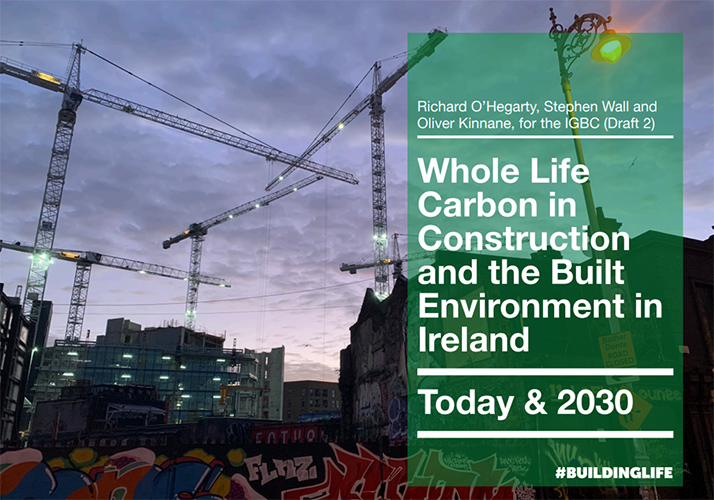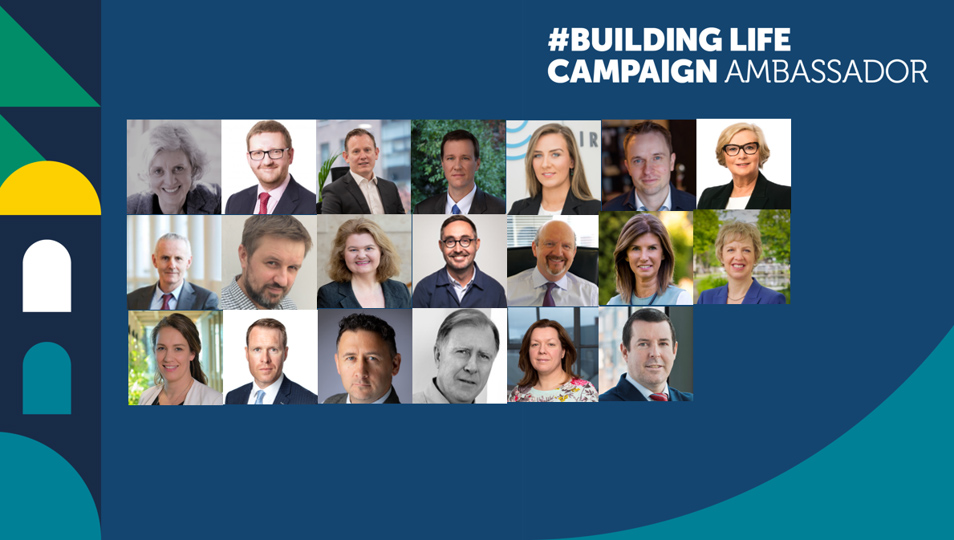
In the first of a series of articles for Irish Construction News on whole-life carbon in construction and the built environment, MARION JAMMET, Head of Policy and Advocacy, IGBC, sets out why the national carbon emissions reduction targets for the built environment will not be achieved through operational emission reductions alone.
The housing and the climate crisis are two of the main challenges facing our society. Based on population growth projections, half a million homes must be built in Ireland by 2040. Last summer, the Intergovernmental Panel on Climate Change (IPCC)’s sixth assessment report highlighted once again that climate change was widespread, rapid, and intensifying.
The scientists who authored the report called for strong, quick and sustained reductions in greenhouse gas emissions to stabilise the climate. This requires all sectors of the economy to fully decarbonise by 2050. As national carbon budgets are being considered in the Oireachtas, this article looks at the current impact of the built environment and construction on Ireland’s emissions and the likely impact of our ambitious construction and retrofit programmes on these emissions.
Addressing the data gap: The impact of the built environment on Ireland’s emissions
EU and global data show that the construction industry and the built environment are both resource and carbon-intensive. According to a 2019 World Green Building Council report, the entire construction process and operation of buildings are responsible for 39% of all carbon emissions globally. Yet, to date, the built environment’s impact on Ireland’s emissions has been poorly quantified.
In our national statistics, buildings-related emissions are associated with the use phase of buildings – ie, with the energy used to heat, cool, and light buildings. But there are emissions associated with all stages of a building life cycle, from raw materials extraction to product manufacturing, construction, and maintenance. To date, these embodied emissions have been included in other sectors, such as transport, industry, waste, and electricity generation, meaning the full impact of construction is not visible. As you can’t improve what is not measured, the Irish Green Building Council (IGBC) commissioned a detailed report from UCD’s Building in a Climate Emergency Research Group on this topic. The Whole life carbon in construction and the built environment in Ireland report looks at the current impact of construction works on Ireland’s emissions and makes projections to 2030 based on the National Development Plan.
“Carbon emissions associated with construction and the operation of the Irish built environment account for more than a third of Ireland’s emissions, the same as agriculture”
Carbon emissions associated with construction and the built environment account for more than one-third of Ireland’s emissions
According to the initial findings of the Whole life carbon in construction and the built environment in Ireland report, carbon emissions associated with construction and the operation of the Irish built environment account for more than a third of Ireland’s emissions (37%), the same as agriculture.
More specifically, the assessment shows that heating, cooling, and lighting our buildings account for 23% of our national emissions, with the remaining 14% being accounted for by embodied carbon. Embodied emissions result from mining, quarrying, transporting, and manufacturing building materials, in addition to constructing buildings. These findings are interesting as this is the first time embodied emissions have been measured in an Irish context. Furthermore, they highlight that the built environment is one of the largest contributors to Ireland’s emissions – much higher than was thought.
Housing and infrastructure plans could see Ireland exceed its 2030 built environment emissions target by over 300%
In 2021, the Climate Action Act enshrined into law the objective of halving Ireland’s emissions by 2030.
The initial projections developed by UCD researchers show that the decarbonisation of the grid, building regulations (NZEB standard) and the ambitious retrofit targets set in the Climate Action Plan (2021) should lead to a significant decrease in operational emissions by 2030. However, the programme will also result in high embodied carbon emissions in the area of renovations as a result of the materials used for renovation projects. Furthermore, the construction of all that is proposed in the National Development Plan (NDP) is projected to result in a built environment with over three times the carbon emissions of the targeted level by 2030 (51% reduction).
Interestingly, the initial assessment highlights the high impact of the roadbuilding programme contained in the NDP. According to the assessment, the embodied carbon for new roads construction would far exceed emissions for construction of any other types of infrastructure, including public transport infrastructure, schools, hospitals, and even infrastructure designed to decarbonise our electricity.
Ultimately, the research shows the national reduction targets for the built environment will not be achieved through operational emissions reductions alone and that embodied carbon must be addressed too.
Decarbonising Ireland’s built environment – next steps
While most of the policy and industry focus to date has been on managing and reducing operational emissions, the publication of the draft report and quality data on embodied emissions is a first step in addressing the environmental impact of Ireland’s built environment across its whole life cycle. With 500,000 new homes and significant pieces of infrastructure planned in the next two decades, taking a more holistic approach to climate action in the built environment is urgent. In fact, these emissions will be released in the near-term horizon, and are both immediate and irrecoverable, ie, unlike operational carbon, embodied emissions cannot be mitigated during the working life of a building.
Decarbonisation roadmap
The whole-life carbon in construction and the built environment in Ireland report will inform the development of a roadmap to decarbonise Ireland’s built environment across its entire life cycle. The IGBC is currently developing the roadmap through extensive stakeholder engagement.
An initial set of recommendations was published in November 2021. This highlighted the need to develop a clear pathway and concrete actions to decarbonise the built environment and the construction industry. Preliminary recommendations included publishing a detailed timeline for mandating whole-life carbon assessment and limits through regulation to provide certainty to industry; streamlining building regulations and aligning all relevant policies and fiscal incentives to make adaptation and reuse of existing buildings easier; and mainstreaming innovative procurement approaches to help encourage and develop a low-carbon product sector, services, and supply chain.
As one of the largest contributors to Ireland’s emissions, the built environment has a vital role to play in achieving our emissions reduction targets. It is hoped that this new data will contribute to raising awareness about the urgency of addressing whole-life carbon in the built environment and that the roadmap will act as a blueprint for policy and industry to decarbonise our sector.
#BuildingLife
The Whole Life Carbon in Construction and the Built Environment in Ireland report was published as part of the #BuildingLife campaign. The #BuildingLife campaign aims to achieve the mix of private-sector action and public policy necessary to tackle the whole-life environmental impact of buildings.
The draft report was produced by Richard O’Hegarty, Stephen Wall and Oliver Kinnane of UCD. A final report will set out the emissions associated with all aspects of construction, including renovation, with reference to the NDP and the Climate Action Plan. This will be published alongside an updated version of the recommendations in May 2022.
The draft Whole Life Carbon in Construction and the Built Environment in Ireland report and IGBC’s initial set of recommendations to decarbonise Ireland’s built environment are available at www.igbc.ie
Oonagh Reid – Irish construction has the potential to be a sustainability pioneer
Arup director and IGBC #BuildingLife ambassador OONAGH REID speaks with Robbie Cousins about the challenges and opportunities she believes the Irish construction sector is facing in helping Ireland meet carbon emission reduction goals up to 2030 and beyond. Click here to read interview





